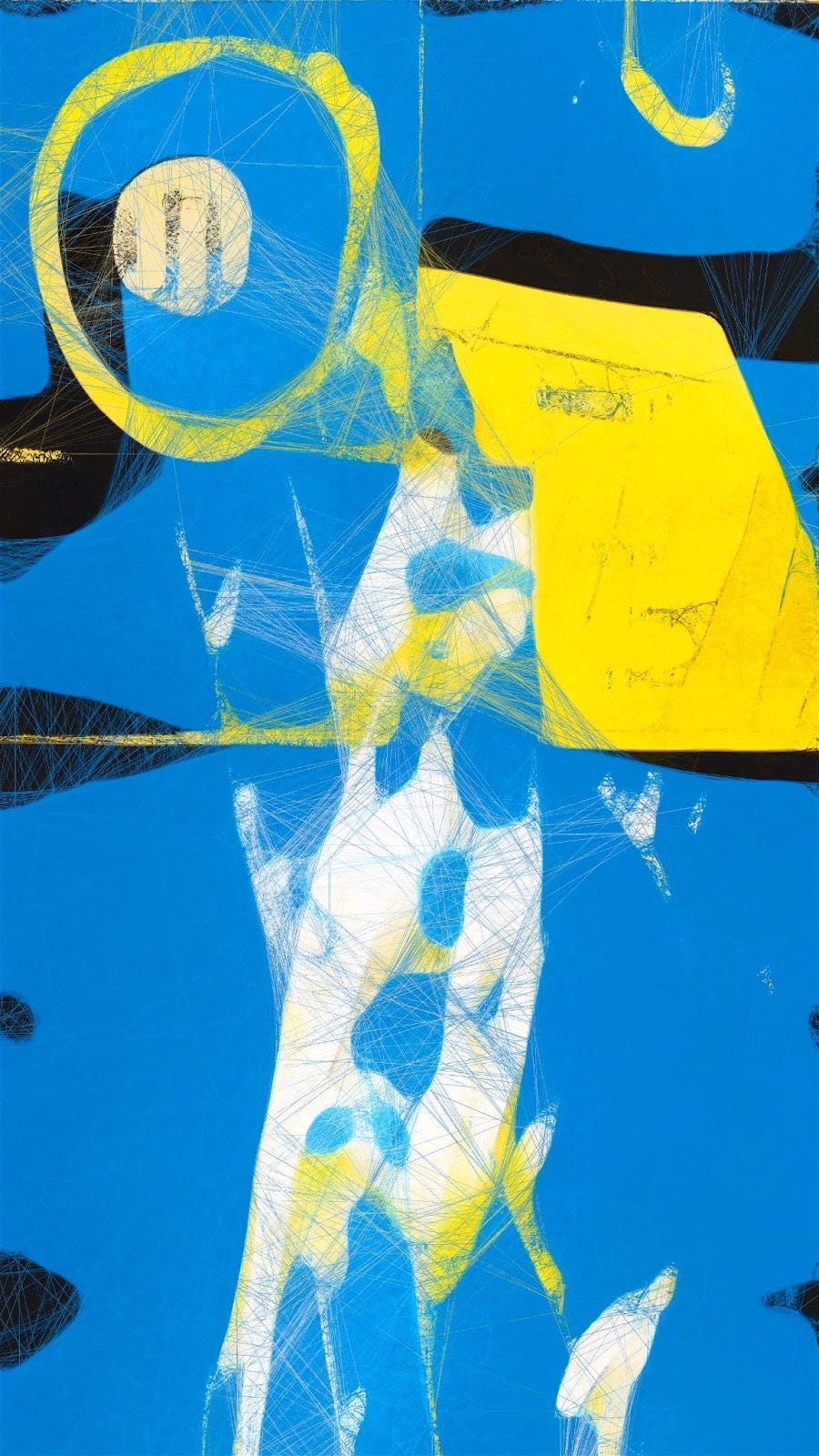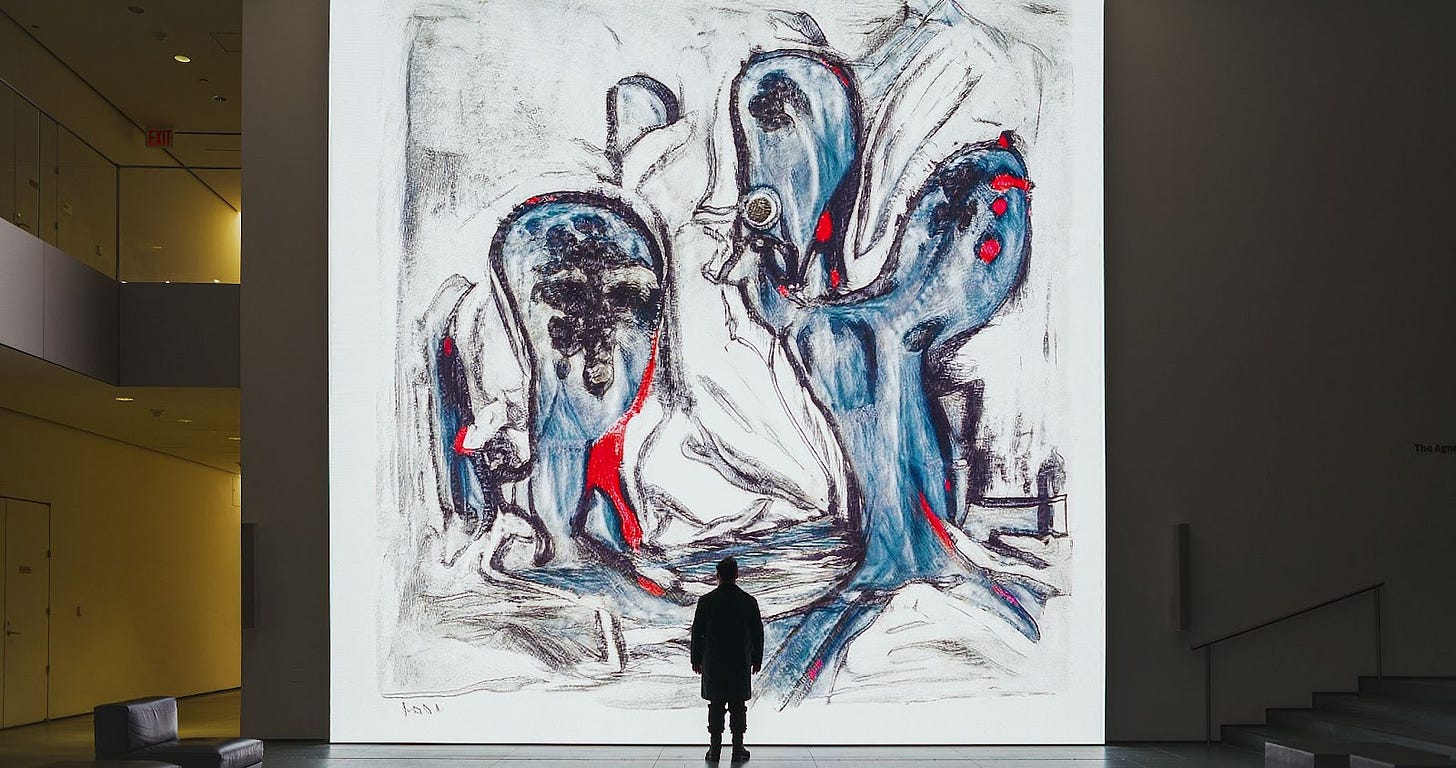Modern Dreams: Refik Anadol’s Unsupervised
By Kevin Buist

Historical moments have a way of feeling both inevitable and entirely unexpected. When Refik Anadol’s Unsupervised came to MoMA’s Gund Lobby in 2022, it was one such historical moment. The generative work, displayed on a 24 foot tall LED screen, mesmerized museum visitors and divided critics. When the art history of this era is written, Unsupervised will be remembered as a convergence of three important trends of the early 2020’s: immersive multimedia installations, NFTs, and artificial intelligence.
Unsupervised was part of an ongoing project by Refik Anadol’s studio called Machine Hallucinations which used AI and large troves of data to speculate about what the “dreams” of machines might be. After training on MoMA’s 178,000 image archive, the GAN learns a continuous latent space—an abstract coordinate grid where each point can be decoded into a plausible new artwork. By sliding through that space or interpolating between two latent vectors, Unsupervised conjures images that echo the collection even though they never existed before. Unsupervised was first exhibited and available to collect on Feral File in November, 2021. A year later, it was put on display at MoMA, where it quickly became a hit, with the exhibition run being extended several times and ultimately lasting nearly a year. More than three million people came to see the work at MoMA, making it one of the museum’s most popular exhibitions of all time. While museum visitors typically look at an artwork for under 20 seconds before moving on, most viewers of Unsupervised lingered for thirty minutes or more.

Unsupervised consisted of several interrelated works, all based on a custom algorithm that finds connections between the 178,000 images from MoMA’s collection that are available in a public database. There are three 1/1 works, Unsupervised — Machine Hallucinations — MoMA (2021), which is an infinite and generative software work that continually uses GAN technology to make new abstract images informed by the formal qualities of images in the MoMA collection. Then there’s Unsupervised — Machine Hallucinations — MoMA Generative Study 1 (2021), which is a three minute video where the visuals are similar to the generative work, but the abstract forms are connected with innumerable small lines as they shift and morph. The third 1/1 work is Unsupervised — Machine Hallucinations — MoMA Fluid Dreams (2021), which is a three minute video that takes the shifting colors and forms from the generative work and adds a fluid dynamics animation, so that particles of color appear to slosh and flow around in a trompe l'oeil architectural frame. There are also nine still image works, each outputs from the generative algorithm, and each offered in an edition of 100. And finally, the collection also included a much larger edition, Unsupervised — Data Universe — MoMA (2021), a 20 second looping video showing a 3-D rendering of the lattice of groupings and connections in the MoMA collection. This work was made in an edition of 5,000, and was available at a more approachable price point.
Unsupervised provided an opportunity for Feral File to collaborate with MoMA on a series of innovative audience engagement experiments. Visitors were able to scan a QR code to get a digital memento on the Tezos blockchain. The memento was a simple NFT that provided an easy way for visitors to get a digital keepsake and learn about digital ownership on the blockchain. The idea was to show rather than tell, so that visitors could get a taste of what crypto could enable in an experimental and interactive way, rather than listening to a lecture about blockchain technology. 50,000 digital mementos were claimed, and Feral File’s app reached over 80,000 downloads, about half of those due to the Unsupervised memento initiative. The digital collectibles were not just a one and done experience, they provided a line of communication and interaction between the collector and the museum. Notifications were pushed to token holders, and experiments were staged, such as giving holders of two tokens a third, or giving collectors of Unsupervised editions free day passes or year long museum memberships.

The concept for Unsupervised first began to form in 2016, when Anadol was the first artist in residence at Google’s Artists and Machine Intelligence Program. This was a time when Google’s DeepDream AI project was making strides, and Anadol’s experiments with various types of GANs (generative adversarial networks) led him to begin the Machine Hallucinations project. Anadol has described the project as a way of “detaching the ego from data,” and allowing latent space of dreams, memories, and hallucinations to be teased out of massive data sets of visual information. The connection to MoMA began with Feral File cofounder Casey Reas, who Anadol once studied under at UCLA. Reas’ discussions with MoMA curators Paola Antonelli and Michelle Kuo eventually looped in Anadol, with the idea of coupling his Machine Hallucinations project with MoMA’s vast digital collection. Feral File presented the exhibition online beginning in November of 2021, a full year before it would eventually be presented in MoMA’s Gund Lobby. In a conversation between Anadol, Reas, Kuo and Antonelli published in MoMA Magazine, Anadol said of working with the archive, “This project is on the shoulders of many giants, like the archive itself, MoMA’s entire digitized collection. And it connects many imaginations across multiple centuries.”
The exhibition at MoMA was both controversial and wildly popular. Scaling the work to the size of a massive wall had a mesmerizing effect. Crowds gathered and sat at the foot of the massive screen, watching it cycle through the three iterations of Machine Hallucinations. The work was originally slated to be displayed for three months, but was eventually extended to nearly a year. Images and videos of the work flooded Instagram and other social media feeds. There were scores of adoring tweets, such as @icreatelife sharing a photo and saying, “When someone tells you that AI art isn’t art, show them this. This is AI art gathering crowds for three months now at MoMA. Refik Anadol with his ‘Unsupervised’. He used publicly available MoMA art as his training data to make this. I’m in awe.”
Installation view of Refik Anadol: Unsupervised, The Museum of Modern Art, New York, November 19, 2022 – March 5, 2023. © 2022 The Museum of Modern Art. Video: Refik Anadol
Critical reception was mixed. Jerry Saltz called it a “screensaver,” and Ben Davis called it amusing and an “extremely intelligent lava lamp.” Lloyd Wise, writing in Artforum, called it “spellbinding.” Some critical skepticism was to be expected, considering that Machine Hallucinations brought together three rapidly evolving threads of art and technology, each variously hailed as the future or dismissed as empty fads: immersive installation, NFTs, and AI. But it’s because of the hype of these movements, not in spite of it, that Machine Hallucinations sits at an inflection point in art history. The work embodies a moment where furious, optimistic, and sometimes overheated artistic experimentation with several new technologies came together into one show-stopping magnum opus.
Unsupervised — Machine Hallucinations — MoMA (2021), the 1/1 generative work, eventually became part of MoMA’s permanent collection. The acquisition was made possible by a joint gift of tech entrepreneur and collector Ryan Zurrer, through his 1OF1 Collection, along with the RFC Collection, led by Pablo Rodriguez-Fraile and Desiree Casoni. The screen that hosted Machine Hallucinations in the Gund Lobby remains, and has since hosted digital artworks by Martine Gutierrez, Leslie Thorton, and Rafaël Rozendaal. MoMA curator Michelle Kuo pointed out that Unsupervised drew not only from the visual traits of MoMA’s collection, but also took conceptual inspiration, saying, “chance and automatism have such a strong presence as strategies in modern art, and in the strategies that artists in MoMA’s collection were using throughout Surrealism, Fluxus, Concrete Art. And then here you get a totally new, different layer of automatism that’s happening.” Madeleine Pierpont, MoMA’s Web3 and Emerging Technologies Manager, reflected on how Unsupervised was a watershed moment for the convergence of art, technology, and visitor engagement at the museum, saying, “It was thrilling to see people of all ages and interests—both digitally native and less technologically inclined—gather around the work, drawn into a shared experience.”

The generative nature of the work aligns it with performance more than video or digital painting. The software is continuously navigating the connections between works in MoMA’s collection, creating new images from the gaps between them, imagining the missing pieces in the canon of modernism. Exactly what it produces cannot be known, it improvises within a set of parameters, performing a hallucination of nonexistent modernist works. Casey Reas said that what he found interesting about Anadol’s work with the MoMA dataset was “that it speculates about possible images that could have been made, but that were never made before. … The data itself is essential to what comes out the other side.” Unsupervised remains one of MoMA’s most popular exhibitions, and a moment where Feral File pioneered new methods for audience engagement whose potential are just beginning to be understood.
Timeline
2016 - Refik Anadol begins Machine Hallucinations while artist in residence at Google’s Artists and Machine Intelligence Program.
November 2021 - Unsupervised first exhibited on Feral File.
November 2022 - Unsupervised opens in MoMA’s Gund Lobby. Memento 1 activation.
December 2022 - Memento 2 activation.
February 2023 - Memento 3 activation.
March 2023 - Memento 4 activation.
May 2023 - Memento 5 activation.
July 2023 - Memento 6 activation.
October 2023 - Unsupervised in MoMA’s Gund Lobby closes.




